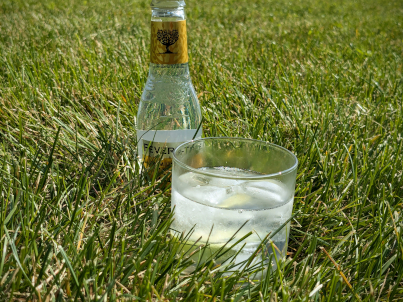Gin & Tonic Summer
I ordered my first Gin & Tonic about 12 years ago at the bar of a steakhouse whose logo, for as long as I can remember, was a frog with a fedora, pointing to the right, ripped wholesale from a The Far Side comic strip. I don't know how they managed to avoid a lawsuit for so long, but god speed I suppose.
The drink itself was... drinkable, I suppose, but I clearly didn't understand it. This was a time in my life where the only cocktails I knew were the Dark & Stormy and a combination of 99 Apples and grenadine that I conjured up because I needed to finish a bottle of 99 Apples I mistakenly thought would be good on its own. The fact that I didn't order a G&T for over a decade afterwards becomes perfectly understandable.
But now... now I kind of know what I'm doing.

You know I praise simple drinks on this site, and the Gin & Tonic is simple. Here's a fact that might surprise you: it only has two ingredients. It's like a Rum & Coke, except ordering a Gin & Tonic doesn't instantly peg you as being in your early 20s.
Gin is easy, and I'm going to cut you some slack this time by saying: pick whatever you gin you like. A London dry is more traditional (more on that in a bit), but the G&T is not a fussy drink like the Martini. In fact, the gin isn't the star of the show here. It's a co-star at best.
Naturally, its partner is tonic water. Specifically tonic water. If you're anything like me circa four months ago, you might have wondered what the big deal was; isn't club soda or seltzer water basically the same thing? Of course, the answer is no; the grocery store wouldn't sell the same thing under three different names. The other two are basically variations on carbonated water.
Tonic water has its origins in the East India Trading Company; it began as a concoction of quinine (as a preventative against malaria) and citrus (as a preventative against scurvy), mixed with sugar to make it not taste so dang bad. Basically, an elixir to help the English sailors keep from getting sick. Of course, gin being the English liquor of choice... you can see how the math adds up. These days, tonic water is a bit dulled down (so don't think you can take a sip and go gallivanting around the jungles of Sri Lanka), but the good stuff still has a little hint of quinine in it to utilize its authentic bitterness.
If you're going to try a Gin & Tonic, I would strongly suggest looking for a tonic water that isn't the cheapest on the shelf. You're already buying good gin (or you better be if you're reading this blog), so you might as well pair it with something that isn't made with corn syrup. Note that this is a rule that not all bars are going to follow, and especially ones in places like hotels and restaurants that have a bar purely for the sake of having a bar. This was likely my mistake 12 years ago. In these places, I wouldn't bother; go ahead and just order a Rum & Coke because that's at least hard to screw up.
Gin & Tonic
- In a rocks glass with ice, add 2 ounces of gin.
- Top with tonic water.
- Garnish with a citrus wedge (lime or lemon).
The result is, you may have guessed, bitter and citrusy, combined with a few floral notes from the gin, and juuust sweet enough to keep it from being completely disgusting. Feel free to play around with the recipe to suit your taste; I've seen recommendations for adding a little (I MEAN IT. JUST A LITTLE) bit of citrus juice, or a few dashes or orange bitters. But that's more work. Who needs that on a lazy summer afternoon?